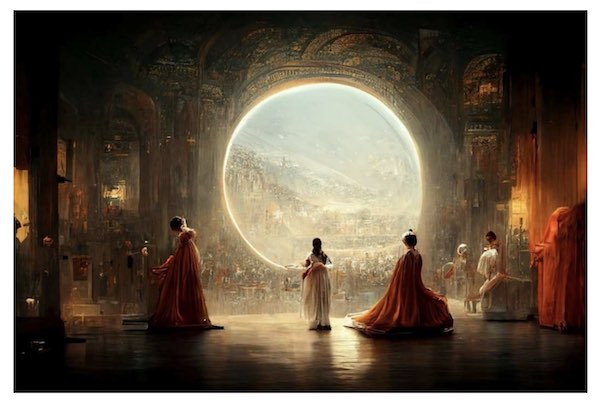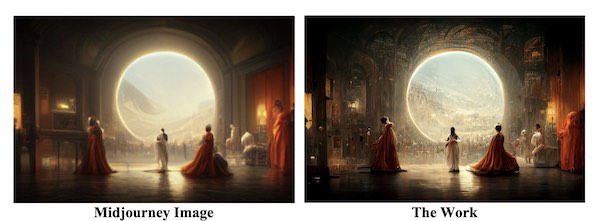“As the Office described in its March guidance, ‘when an AI technology receives solely a prompt from a human and produces complex written, visual, or musical works in response, the ‘traditional elements of authorship’ are determined and executed by the technology—not the human user.’” – Copyright Office Review Board

Source: Copyright Office decision
Earlier this week, the Review Board of the U.S. Copyright Office published a decision denying registration of a work created using the generative artificial intelligence (GAI) system, Midjourney, highlighting the complexities such technology is introducing to the U.S. copyright system.
Copyright Office Guidance
In March, following some high-profile cases involving works made using GAI, the Office issued a statement of policy indicating that, in assessing registrability of works including AI-generated content, it will first ask “whether the ‘work’ is basically one of human authorship, with the computer [or other device] merely being an assisting instrument, or whether the traditional elements of authorship in the work (literary, artistic, or musical expression or elements of selection, arrangement, etc.) were actually conceived and executed not by man but by a machine.”
If a work contains AI-generated material, the Office will first consider “whether the AI contributions are the result of ‘mechanical reproduction’ or instead of an author’s ‘own original mental conception, to which [the author] gave visible form.’” This will depend on the particular circumstances, how the AI tool works and how it was used, and will be determined on a case-by-case basis.
If a work is determined to have been created solely by a machine, it will not be registered. The Office called out Midjourney as an example of AI tools that generate complex musical, visual and written works with a simple prompt from a human. “Based on the Office’s understanding of the generative AI technologies currently available, users do not exercise ultimate creative control over how such systems interpret prompts and generate material,” wrote the USCO.
Disclose and Disclaim
In line with that guidance, the decision issued this week found that Jason M. Allen’s two-dimensional artwork, titled “Théâtre D’opéra Spatial,” contained “more than a de minimis amount” of AI-created content and that the AI content must therefore be disclaimed.
According to the Copyright Office guidance, where AI-generated works also contain enough human authorship to support copyright protection, the Office will grant registration of “the human-authored aspects of the work,” but the AI-generated portions must be disclaimed and the use of AI tools disclosed.
Allen did not disclose his use of Midjourney to create the work in the application, but his work had drawn national attention as “the first AI-generated image to win the 2022 Colorado State Fair’s annual fine art competition,” according to the decision. The examiner therefore requested additional information about the use of Midjourney in creating the work.

Source: Copyright Office decision
In his response, Allen explained that he “input numerous revisions and text prompts at least 624 times to arrive at the initial version of the image.” He also used Adobe Photoshop to “remove flaws and create new visual content and used Gigapixel AI to ‘upscale’ the image, increasing its resolution and size.”
The Office asked Allen to disclaim the features of the work created by Midjourney but he refused. According to the decision, the examiner thus rejected the work because it “did not ‘fix only [Mr. Allen’s] alleged authorship’ but instead included ‘inextricably merged, inseparable contributions’ from both Mr. Allen and Midjourney.”
Allen then requested that the Office reconsider his request, but the work was refused registration again. However, the Office did acknowledge that the “visual edits” made with Adobe Photoshop “contained a sufficient amount of original authorship to be registered” but that the elements created using Midjourney and Gigapixel AI still could not be registered.
Allen: Denying AI-Generated Works is a Value Judgment
Allen submitted a second request for reconsideration in July, presenting several additional arguments. First, he said that “in finding that the image generated by Midjourney lacks the human authorship essential for copyright protection, ‘the Office ignore[d] the essential element of human creativity required to create a work using the Midjourney program.’” He also said the work should be registrable under the fair use doctrine because it “allows for transformative uses of copyrighted material.” Finally, Allen argued that “by refusing to register content generated via Midjourney and other generative AI platforms, ‘the Office is placing a value judgment on the utility of various tools,’ and that denial of copyright protection for the output of such tools would result in a void of ownership” and that the Office’s requirements for registration of AI-assisted works is overly burdensome.
In its discussion and analysis, the Review Board determined that the core Midjourney image was not copyrightable, and that it could not decide whether the adjustments made in Adobe Photoshop would be copyrightable on their own because there was insufficient information to make that determination. Allen conceded that the Gigapixel AI additions did not “introduce new, original elements into the image” that equate to authorship. The Office further explained its reasoning for once again refusing registration:
“In the Board’s view, Mr. Allen’s actions as described do not make him the author of the Midjourney Image because his sole contribution to the Midjourney Image was inputting the text prompt that produced it…. It is the Office’s understanding that, because Midjourney does not treat text prompts as direct instructions, users may need to attempt hundreds of iterations before landing upon an image they find satisfactory. This appears to be the case for Mr. Allen, who experimented with over 600 prompts before he ‘select[ed] and crop[ped] out one ‘acceptable’ panel out of four potential images … (after hundreds were previously generated).’… As the Office described in its March guidance, ‘when an AI technology receives solely a prompt from a human and produces complex written, visual, or musical works in response, the ‘traditional elements of authorship’ are determined and executed by the technology—not the human user.’”
Copyright Office: We’re Not Looking for a Detailed Disclosure
The decision went on to find that, 1) while “the process of prompting can involve creativity,” Allen’s use of prompts did not rise to that level; 2) that there is no policy problem because the Constitution and the Copyright Act expressly exclude works authored by non-humans; 3) the requirement to disclose AI tools does not place a value judgment on those tools but merely recognizes “the fact that ‘[h]uman authorship is a bedrock requirement of copyright,’”; 4) that Allen’s fair use argument is misplaced because fair use does not address copyrightability, but use; and 5) that the requirement to disclaim the non-copyrightable work is not meant to be burdensome. On the latter point, the Office explained:
“The Office does not require a detailed disclosure of the specific identity and creative process behind the AI-generated material in a work. The Office’s guidance merely requires applicants to provide a ‘brief statement’ in the application, such as the text ‘generated by artificial intelligence.’”

![[IPWatchdog Logo]](https://ipwatchdog.com/wp-content/themes/IPWatchdog%20-%202023/assets/images/temp/logo-small@2x.png)

![[Advertisement]](https://ipwatchdog.com/wp-content/uploads/2024/04/UnitedLex-May-2-2024-sidebar-700x500-1.jpg)
![[Advertisement]](https://ipwatchdog.com/wp-content/uploads/2024/04/Artificial-Intelligence-2024-REPLAY-sidebar-700x500-corrected.jpg)
![[Advertisement]](https://ipwatchdog.com/wp-content/uploads/2024/04/Patent-Litigation-Masters-2024-sidebar-700x500-1.jpg)

![[Advertisement]](https://ipwatchdog.com/wp-content/uploads/2021/12/WEBINAR-336-x-280-px.png)
![[Advertisement]](https://ipwatchdog.com/wp-content/uploads/2021/12/2021-Patent-Practice-on-Demand-recorded-Feb-2021-336-x-280.jpg)
![[Advertisement]](https://ipwatchdog.com/wp-content/uploads/2021/12/Ad-4-The-Invent-Patent-System™.png)






Join the Discussion
3 comments so far.
Raymond Van Dyke
September 11, 2023 10:58 amIf the human refused to demonstrate any minimal creativity (to push the issue), then the Office is correct in denying the work. The USPTO is dealing with this issue in AI-generated inventions, a much higher threshold.
Anon
September 8, 2023 12:17 pmThis: “The Office asked Allen to disclaim the features of the work created by Midjourney but he refused.”
Given this, the rest of the assertions (of the putative author) means nothing.
Without more, there is NO ‘hair to split,’ as the examiner is given no choice upon WHAT to split.
If the author has gone to the trouble to outline 654 inputs, why not answer the question that lies at the heart of the examination?
Raymond Van Dyke
September 8, 2023 11:36 amAs per the Supreme Court, copyright works must be original and exhibit some minimal level of creativity. Feist Publications, Inc. v. Rural Telephone Service Co., 499 U.S. 340 (1991). If we can embellish telephone numbers and make that new work copyrightable, all a human must do is embellish (in at least a minimal way) an AI-generated work. I understand that completely AI-generated works are not “original” human works, but a tweaked image should be per se copyrightable. Making value judgments on whether or not a human adjustment is enough (or worthy) reminds me of the Alice abstract subjectivity test, in the eye of the beholder. Need we split hairs in copyright too?